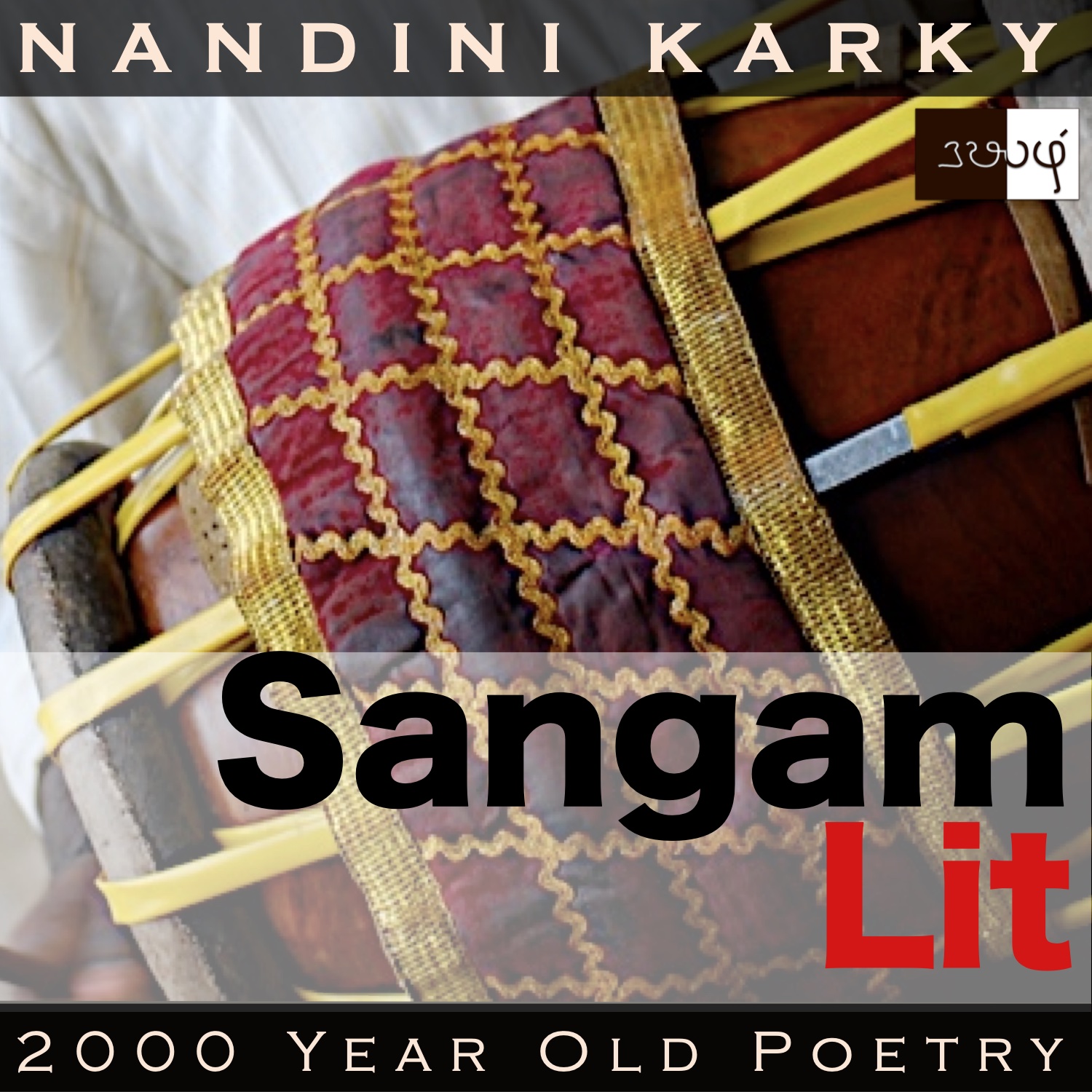Podcast: Play in new window | Download
Subscribe: Apple Podcasts | Spotify | Amazon Music | Android | iHeartRadio | TuneIn | RSS | More

In this episode, we observe the acceptance of an unexpected event, as depicted in Sangam Literary work, Kurunthogai 15, penned by Avvaiyaar. The verse is situated in the drylands of ‘Paalai’ and speaks in the voice of the lady’s foster mother to the birth mother, announcing the truth about the lady’s relationship.
பறை பட, பணிலம் ஆர்ப்ப, இறைகொள்பு
தொல் மூதாலத்துப் பொதியில் தோன்றிய
நால் ஊர்க் கோசர் நல் மொழி போல,
வாய் ஆகின்றே-தோழி!-ஆய் கழல்
சேயிலை வெள் வேல் விடலையொடு
தொகுவளை முன்கை மடந்தை நட்பே.
As if arising from a town crier’s mouth, accompanied by his drum beats, the verse echoes in our ears! Indeed, the first words mention ‘பறை பட’, talking of the famous Sangam-era ‘drums, which are thundering’, which is also complemented by ‘the far-reaching sounds from a conch-shell’, as seen in the words ‘பணிலம் ஆர்ப்ப’. Next, we get to meet ‘an ancient banyan tree’ in ‘தொல் மூதாலம்’. Imagine how old this banyan tree must be to be called as ancient by these ancient folk! I read that the lifespan of a banyan can be more than 500 years. A sense of awe is inevitable when reflecting on such a tree and this same feeling seems to have shone in the hearts of those ancients for they held a belief that ‘gods resided in that tree’ as seen in the words ‘இறைகொள்பு’. A clear indicator that it’s in nature that ancient people got their first glimpse of the divine! Returning, we meet an ancient tribe in ‘நால் ஊர்க் கோசர்’, who find a mention in many other Sangam works. Thereafter, we see how the man and lady are characterised by the accessories they wear in ‘ஆய் கழல்’ meaning ‘exquisite warrior’s armlets’ and ‘தொகுவளை’ meaning ‘rows of bangles’. Ending with ‘மடந்தை நட்பே’ meaning ‘the lady’s relationship’, the verse beckons us to know more!
What could be that resounding statement about the lady’s life? Let’s explore the context for clues. The man and lady were in a love relationship and realising that they could not be united otherwise, decide to elope away. Helping them to fulfil their decision, the confidante sends them away and then declares to her mother, who is also the foster mother of the lady, about how the lady has left her home with the man. Learning of this, the foster mother goes to the birth mother and says, “Drums resounding, conches echoing, akin to the good words of the ‘Naaloor Kosars’, who assemble under the old banyan, in which gods reside, it has become true, my friend. I speak of the love relationship between the young man, wearing a warrior’s armlets and wielding a white spear with a red-leaf tip, and the young lady, wearing tiers of bangles on her forearm, which has now become an actuality!” With these words, the foster mother informs the lady’s birth mother about how the man and lady were now united as one!
The nuances lie in wait to be explored! Mentioning the loud beats of drums and the blaring of conches, the foster mother starts her conversation with the lady’s mother. Then, she brings in a simile involving the words spoken by a tribe called the ‘Naaloor Kosars’, who are said to gather beneath an ancient banyan. The foster mother equates the word of the ‘Kosars’ to how something has come true! A moment to look at this tribe and their significance. Numerous Sangam poems mention these Kosars, who were respected as an upright people, who never went back on their words. Even now, the epithet ‘வாக்கு தவறாதவர்’ meaning ‘someone who never sways from their word’ is high praise in contemporary Tamil social life and through this two-thousand year old verse, we can connect to the origins of this reverence for truth. Returning, the foster mother says that akin to the words of the Kosars, the lady’s relationship with the man has come true. It’s in connection with how this has come true that she has mentioned the drums and conches in the beginning. Apparently, these were used to announce the wedding of a couple to the whole town and making that connection, the foster mother informs the lady’s mother that her daughter is now married and has chosen the just path to fulfil her love relationship.
I cannot help exclaiming at this curious family set-up, where the girl has a confidante, who manages her love relationship, and who is in fact, the daughter of the foster mother, who raised the lady as a young child, and who also happens to be the confidante to the lady’s birth mother. Mind-boggling, isn’t it? Was it the custom of the confidante to travel along with the lady to the man’s town, marry someone and have her children then become friends of the lady? Is the window to the social life of the Sangam people thrown open by these verses, true like the word of the Kosars, or were they figments of imagination? Hopefully, science, through research in archaeology and genetics, will help us learn of the deep truth behind this art form, someday!




Share your thoughts...